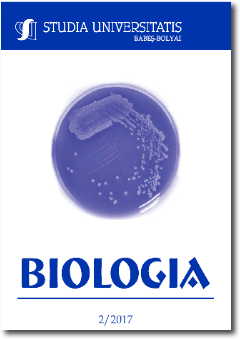Bio-chemical analysis of “Datura stramonium” extract
DOI:
https://doi.org/10.24193/subbbiol.2017.2.01Keywords:
atropine, bacterial susceptibility, Datura stramonium, High Performance Liquid Chromatography with reversed phase, scopolamine, thin-layer chromatography.Abstract
Datura stramonium is an annual plant which belongs to the Solanaceae family. Datura stramonium is also a toxic plant, with toxicity given by the presence of alkaloids hyoscyamine, atropine and scopolamine.This study performs phytochemical and antibacterial analysis of ethanolic extracts from Datura stramonium. Fresh plants have been used in order to obtain Datura stramonium tincture. The quality index was 1:5, the concentration of ethanol being 90%. Based on this tincture a qualitative and quantitative phytochemical analysis was performed through thin layer chromatography and high performance liquid chromatography. By thin-layer chromatography the qualitative alkaloids, such as atropine and scopolamine from Datura stramonium extract, have been identified. By high performance liquid chromatography with reversed phase the alkaloids quantity from Datura stramonium herbs was assessed and that is 1.7 mg/mL. The plant extracts were tested on Gram negative bacteria Escherichia coli and on Gram positive bacteria Staphylococcus aureus. Both tested strains showed resistance but for E. coli a higher inhibition was observed at all samples containing Datura extract.
References
Akal, Z.U., Gürkan, S., Alpsoy, L., Yildiz, A. (2014) Evaluation of cytotoxic and cenotoxic effects of Datura stramonium extracts on cultured human lymphocytes, Medicinal & Aromatic Plants, 3:4, 1-8
Alvarez, M. ., Marconi, P.L. (2011) Genetic transformation for metabolic engineering of tropane alkaloids, InTech, 291-300
Atlas, R.M. (2010) Handbook of microbiological media, 4th edition, CRC Press, New York
Behçet, A. (2014) The source-synthesis-hystory and use of atropine, The Journal of Academic Emergency Medicine, 13:2-3
Carpa, R., Drăgan-Bularda, M., Muntean, V. (2014) Microbiologie generală lucrări practice, Ed. Presa Univ. Clujeană (in Romanian)
Chandra, S. (2012) Biotechnology for medicinal plants, Micropropagation and Improvement, Springer, pp 464
Dubrovsky, J.G., Rost, T.L. (2012) Pericycle, Wiley online Library, eLS
Facchini, P.J. (2001) Alkaloid byosynthesis in plants: biochemistry, cell biology, molecular biology and metabolic engineering applications, Annual review of plant physiology and plant molecular biology, 52, 29-66
HAB (Homöopathisches Arzneibuch) (2011) Deutscher Apoheker Verlag
Hashimoto, T., Hayashi, A., Amano, Y., Kohno, J., Iwanari, H., Usudal, S., Yamada, Y. (1991) Hioscyamine 6ß-hydroxylase, an enzyme involved in tropane alkaloid biosynthesis, is localized at the pericycle of the root, The Journal of Biological Chemistry, 266, 7, 4648-4653
Indra, K.V. (2012) Cell Culture and Somatic Cell Genetics of Plants, Vol. 4 Cell culture in phytochemistry, Elsevier, pp 330
Iranbakhsh, A., Ali Oshanghi, M., Majd, A. (2006) Distribution of atropine and scopolamine in different organs and stages of development in Datura stramonium L. (Solanaceae). Structure and ultrastructure of biosynthesizing cells, Acta Biologica Cracoviensia Series Botanica, 48,1: 13–18
Kandoth, K.P., Singh, S., Jayabaskaran, J. (2010) Expression of hyoscyamine 6β-hydroxylase in root pericycle cells and accumulation of its product scopolamine in leaf and stem tissues of Datura metel L., Plant Science, 178, 2: 202-206
Kanegae, T., Kajiya, H., Amano, Y., Hashimoto, T., Yamada, Y. (1994) Species-dependent expression of the hyoscyamine 6β-hydroxylase gene in the pericicle, Plant Physiol., 105, 483-490
Kasture, A.V., Wadodkar S. G. (2008) Pharmaceutical Chemistry I, Pregati Books Pvt. Ltd., pp 215
Kumar, A. (2009) A text book of practical botany II, Seventh edition, Rastogi Publications, India, pp 646
Liu, S., Li, L., Shen, W., Shen, X., Yang, G., Zhou, W. (2013) Scopolamine detoxification technique for heroin dependence: a randomized trial, Neuroscience and Biobehavioral Reviews, 34: 1307 – 1350
Mann, J. (2008) Belladonna, broomsticks and brain chemistry, Royal society of Chemistry
Reddy, U.B. (2009) Antimicrobial activity of Datura stramonium L. and Tylophora indica (burm.f.) Merr, Pharmacologyonline, 1: 1293 – 1300
Roberts, H. (Editor), (2007) Handbook of Plant Science, Vol. 2, Wiley, pp 1599
Roberts, M.F., Wink, M. (eds.) (2013) Alkaloids: biochemistry, ecology and medicinal applications, Spinger Science & Business Media, New York, pp 482
Schmelzer, G.H., Gurib-Fakim, A. (2008) Medicinal plants, vol 1, Prota foundation, pp. 791
Sharma, P., Sharma R.A. (2013) Comparative antimicrobial activity and phytochemical analusis of Datura stramonium L. plant extracts and callus in vitro, Eur. J. Med. Pl., 3(2): 281-287
Shobha, G., Soumya, C., Shashidhara, K.S., Vinutha M. (2014) Phytochemical profile, antibacterial and antidiabetic effects of crude aqueous leaf extract of Datura stramonium, Pharmacophore, 5(2), 273-278
Sreenivasa, S., Vinay, K., Mohan, N. R. (2012) Phytochemical analysis, antibacterial and antioxidant activity of leaf extract of Datura stramonium, International Journal of Science Research, 1, 83-86
Sweta, V.R., Lakshmi, T. (2015) Pharmacological profile of tropane alkaloids, Journal of Chemical and Pharmaceutical Research, 7 (5): 117 – 119
Venkanna, B., Uma, A., Suvarnalaxmi, C.H., Jayalaxmi, L. (2013) Antimicrobial property of Datura leaf extract against methicillin-resistant Staphylococcus aureus isolated from uresthral and skin suppurative infections, Current Trends in Biotechnology and Pharmacy, 7 (3) 782-792
Yang, Y., Dang, Y., Li, Q., Lu, J., Li, X., Wang, Y. (2014) Complete chloroplast genome sequence of poisonous and medicinal plant Datura stramonium: organizations and implications for genetic engineering, Plos One, 10 (2)
Downloads
Published
How to Cite
Issue
Section
License
Copyright (c) 2017 Studia Universitatis Babeș-Bolyai Biologia

This work is licensed under a Creative Commons Attribution-NonCommercial-NoDerivatives 4.0 International License.





